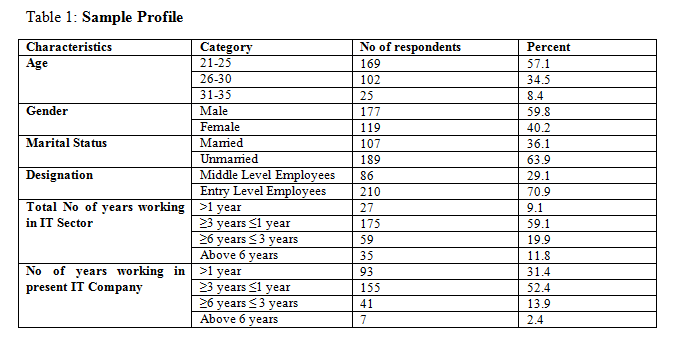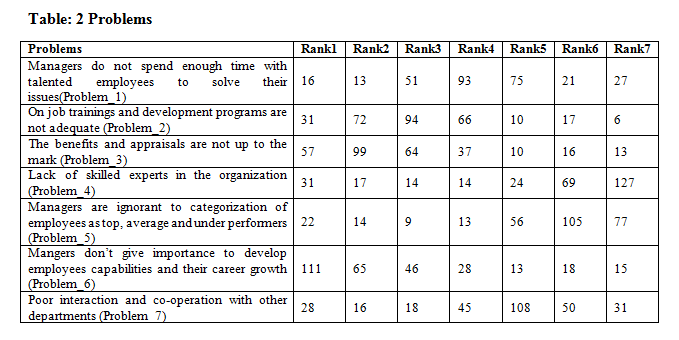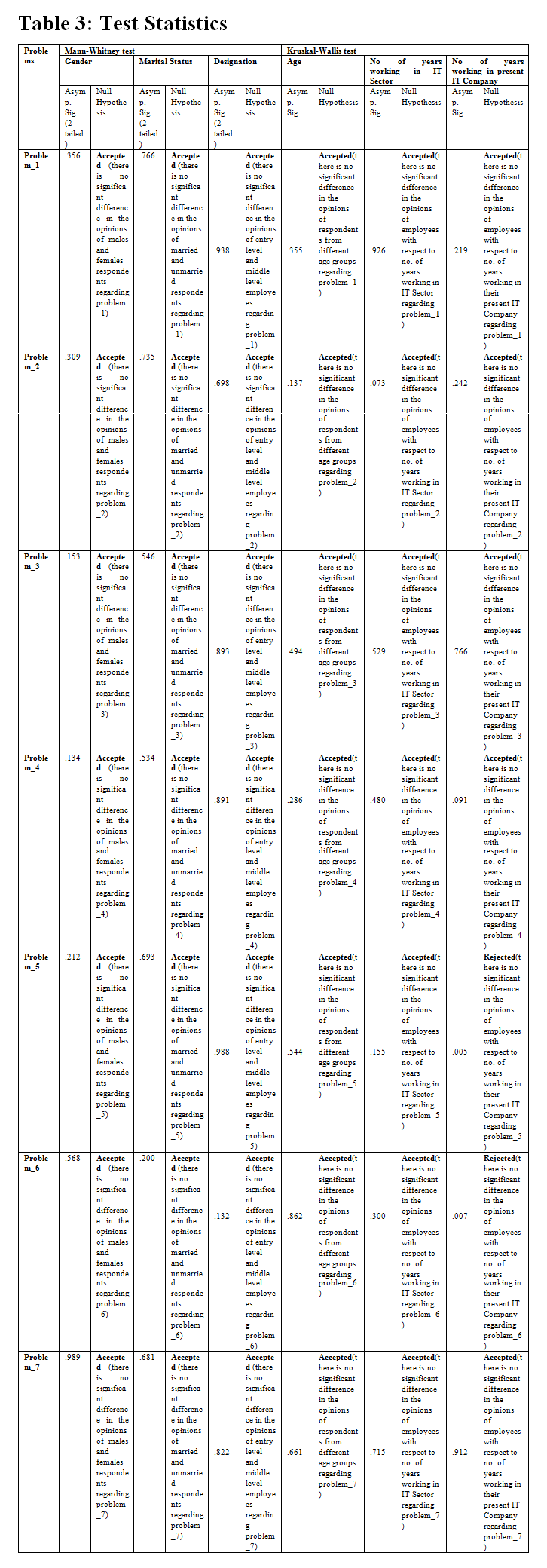|
Kavita Rani PhD Scholar Department of Commerce Maharshi Dayanand University, Rohtak E-mail: kvg5gulia@gmail.com Contact No. +919728294410 |
Dr. Sanjiv Kumar Professor Department of Commerce Maharshi Dayanand University, Rohtak E-mail: sanjivkmdu@gmail.com Correspondence Address House No – 1599, Sector 10-A Gurgaon (Haryana) - 122001 |
Drawing on the literature on talent management implies that the effective implementation of talent management practices and strategies in an organization are indeed associated with the outcomes such as reduction in talent attrition rate and heightened productivity. The present paper seeks to investigate and explore the problems faced in the successful implementation of talent management practices. For the accomplishment of this objective, data were collected from 296 IT Sector employees working in NCR with the help of self structured questionnaire. Kruskal Wallis H-test, Mann-Whitney test and Rank Correlation test for agreement in multiple judgments were used for further analysis of the data. The results of the study highlighted that mangers don’t give importance to develop the employee’s capabilities and their career growth which in turn leads to talent attrition in IT Sector in India. At the same time no significant difference in the opinions of the respondents were found when we categories them age-wise, gender-wise, marital status-wise etc. regarding different problems. However an exception in differences in opinion was found among employees with regard to certain problems with respect to their experience in their current organizations.
Key words: Talent management, employees, IT Sector
India has emerged as one of the fastest growing market. The Indian IT Sector has not only revolutionized India's image on the global front, but has also fuelled our economic growth by encouraging the higher education sector especially in engineering and computer sciences. The IT sector is not only significantly contributing to the economy but is also creating employment opportunity especially for our young generation. India has the world largest pool of highly qualified technical graduates making it as a most preferred destination for outsourcing and most lucrative sector for investments. However when we talk about the attrition rate, IT Sector is on the top in the list, which affect the organization adversely. The attrition rate is higher in junior-level of employees which would be up to 30 percent in coming times whereas in middle level management would witness 20 percent attrition rate. The attrition rate would be lowest in top management employees Times of India (2014). Whenever a well-trained and talented employee leaves the organization, it not only creates a vacuum in the organization but also have results into several expenditures to fill in that vacuum. Hence at this stage, it is not the exaggeration to assert that talent management practices have become an imperative in the face of today's business challenges. Although there are several definitions of talent management still the meaning is somewhat tenuous. According to Iles et al. (2010a) and Capelli (2008), talent management includes human resource management but talent management emphasizes on the talented employees. The focal point of talent management is talent pool. It is also the implementation of integrated strategies or systems designed in order to increase the workplace productivity by developing improved processes for attracting, developing, retaining and utilizing people with the required skills and aptitude to meet current and future business needs. Talent management practices considered for the study include recruiting and staffing, competency management, leadership development and assessment, performance management, compensation and engagement. From the extant literature pertaining to talent management practices, the researcher found that the most critical step in talent management is the successful implementation of talent management practices by facing all the challenges that come in its way.
Nevertheless, most of the organizations are implementing talent management practices in their respective organizations but there are lot of challenges in its successful implementation that need to be invested Poorhosseinzadeh and Subramaniam (2012). In light of the dearth of research on talent management in IT Sector, it would be helpful to consider the studies related to other sectors and countries also. A Study in Thailand by Piansoongnern et al (2011) revealed that the human resource practitioners wished to manage the individual talent for encouraging and unleashing employee’s potential but the challenge arises that they do not know how and where to begin the process which results into dullness of the HR practitioners as they are not able to contribute to the pool of talent management by not effectively contributing the ideas. In many organizations the weakest component in the successful implementation of talent management programme is the lack of differentiation between the employees. Silo mentalities with short term and parochial thinking of the leaders also create problems in the way of effective talent management practices. The cost and time involved in meeting face to face often restrict the full understanding and communication across the organization. According to India talent survey report by Deloitte in 2012, 54% of employees were searching for new jobs because of lack of increase in compensation whereas 52% of employees said that there is lack of career options in the software companies in India. For the Indian workforce promotional opportunities, additional compensation and opportunities to work abroad are major driving motivators for retention. In the North America 25% of the organizations claims that they have created the talent management systems but are facing challenges in its implementation. Maria-Madela and Mirabela-Constanta (2008) revealed seven obstacles in which highest number of respondents said that the senior managers do not spent enough time on talent management. They are unwilling to differentiate the employees as top, medium and lower performers. Although talent management plays a greater role within the organizations, but still there is doubt that how government in practice can implement effective talent management. Every company has the top performer employees, who are a head of their colleague in terms of the value they bring in the organization; acquiring and retaining those workers by helping them grow in their careers, is a major threat Njeri and Orwa(2011). The growing priority to work-life balance by the employees also has implications in the implementation of talent management strategies Charted Institute of Personnel and Development (2006). According to an article in Business Standard (2014) lack of opportunities in the current job roles makes the talented employees to leave their organizations and these departures only lead to increase in companies expenditures.
· To identify and evaluate the problems in effective implementation of talent management practices.
· To evaluate the relationship of the problems faced in effective implementation of talent management practices with demographic variables.
The fundamental objective of this study is to underline and explore the major problems in the effective implementation of talent management practices in IT sector which will help the management in improving their talent management system so that the organization would compete more effectively in the present hyper competitive business world. A descriptive survey design was used to identify and evaluate the problems in the implementation of talent management practices in six conveniently selected IT Multinational Companies operating in Gurgaon and Noida. The companies were selected on the basis of the number of employees. Convenience sampling method was used for the collection of the data. A thorough literature review was conducted and seven variables (problems) were identified. Self structured questionnaire was used for the collection of the data. The questionnaire comprise information related to respondent’s socio demographics i.e. age, gender, marital status, designation etc. and the seven variables (problems). The respondents were asked to assign ranks to these seven problems faced by them ranging from least likely to be faced (1) to most likely to be faced (7) on an ordinal scale. 350 targeted respondents participated in the survey but after the elimination of the partially filled questionnaires, 296 were the usable questionnaires. The data collected by means of the questionnaire were further processed with the help of IBM SPSS 21 Software. For hypothesis testing, the rank correlation test for agreement in multiple judgments, Mann-Whitney test and Kruskal-Walis test was used. The rank correlation test for agreement in multiple judgments was used to know that is there is any consistency between the ranks assigned by the respondents Kanji (2006). Mann-Whitney test was used to compare the distributions in two conditions or groups (gender, marital status, designation) and these conditions contain different entities but when there are more than two groups (age, experience in IT sector, experience in present IT company) then the researchers used Kruskal-Walis test Field (2013).
In order to simply the data, this section of the paper deals with tabulation, hypothesis testing and their interpretations.

With the help of frequency and percentage analysis, the above table 1 depicts the demographic insights of the sample respondents. It shows that the highest percentage of the respondents was from the 21 to 25 age group among all other categories covered by the survey. 59.8 percent (117) of the respondents were males while 40.2 percent were females. There is difference (63.9-36.1=27.8 percent) in the marital status of the respondents. Majority of the respondents were from the entry level in the company. The highest percentage of the employees (respondents) said that they have more than three years but less than six years of experience in the IT Sector. As we can see from the table above, 52.4 percent of employees are stick to their present IT Company from more than one year but less than and equal to three years.

Above table summarizes the responses of the employees regarding different problems by ranking them 1 to 7. Highest number of employees said that the manager’s in companies don’t give importance to develop their capabilities and career growth as they assigned first rank to it which is followed by problem_3 i.e. the benefits and appraisals are not up to the mark. Highest number (99) of respondents provided second rank to the problem_3 and said that the benefits and the appraisals are not up to the mark. On the other hand, lowest number of employees assigned second rank to the problem_1. Moreover, 94 (highest number) respondents stated that on job trainings and development programs are not adequate and provided it third rank. Similarly, the highest number of employees assigned fourth and fifth rank to problem_1 and problem_7. Problem_5 and Problem_4 are least facing by the employees as they assigned them rank 6 and 7.
Hypothesis testing: H01: There is no correlation between the ranks assigned by the respondents to problems.
With the help of rank correlation test for agreement in multiple judgments Kanji (2006) the analysis shows that reject the null hypothesis (H01) as the value of F (F6; 2065; 0.05) is greater than the critical value (2.10, Table 3) of the F-distribution. So there is correlation between the ranks assigned by the respondents and we can say that the problems are not independent to each other.

Above table 3 depicts the results of Mann-Whitney test and Kruskal Wallis test. Mann-Whitney test was used to know the significant difference in the opinions of the respondents related to different problems when there are two groups (gender, marital status and designation) and when there are more than two groups (age, total no of years of working in IT Sector and total no of years working in present IT Company) Kruskal-Wallis test was used. Mann-Whitney test statistics revealed that there is no significant difference in the opinions of males and females, married and unmarried and middle level and lower level employees towards the identified problems
faced in the implementation of talent management practices as the p-value in all cases is greater than .05 and hence the null hypothesis were accepted whereas Kruskal-Wallis test statistics revealed that there is no significant difference in the opinions of respondents if we categories them age-wise or on the basis of their experience in IT Sector. but we categorize them on the basis of their experience in their present IT Company the opinions of the employees are different regarding problem_5 and problem_6 i.e. mangers don’t give importance to develop employee’s capabilities and career growth (problem_5) and managers are ignorant to categorization of employees as top, average and under performers (problem_6).
Conventional wisdom says higher is the number of the talented employees leaving the company, it is an eye opener for the management to start looking that what is going wrong within the company. Drawing insights from literature review we recognize that the rising double-digit attrition rate witnessed by the IT Sector, having a catalytic effect on the separation of talented employees in present cut throat and hyper competitive commercial environment. On the other hand, from the economic point of view, switching of job by an employee from one organization to another is a sign of market recovery showing the presence of more lucrative opportunities for the pool of talented employees which instills the confidence in them to find better alternatives with higher compensation and benefits. In spite of the phenomenal growth in the Indian IT Sector, talent attrition rate is an alarming and top burning obsession for our software companies which in turn are showing an adverse impact on the smooth functioning of their respective business activities. Indian IT Sector is completely a manpower driven sector which is highly dependent on the talented employees and management of these talented IT professionals is the supreme task for software companies. Therefore in today’s fast moving knowledge economy, talent management practices have gained a significant attention of software companies to retain the talented employees. But when we talk about the effective implementation of talent management practices, the IT Sector is facing several problems. For the IT companies, it is the toughest time to keep the talented employee motivated and engaged at the highest levels to minimize attrition and at the same time increase in the productivity. The present study focused on the identification of those problems which are being faced by the IT Companies in the successful implementation of talent management practices.
It is therefore, the study revealed that majority of respondents said that the managers don’t give importance to develop employee’s capabilities and their career growth. According to Business Standard (2014), lack of opportunities in the company is inducing the employees for more departures. Moreover, the respondents said that the benefits and the appraisals are not up to the mark as majority of the respondent’s assigned second rank to this problem. Availability of the better monetary prospects in other companies is driving the employees to switch their jobs. The seven problems which are identified with the help of literature review are dependent and related to each other therefore a fully integrated and coordinated talent management strategy should be formulated and implemented. Whereas the opinions of the respondents towards different problems from different age group, males and females, married and unmarried, middle level and lower level employees and on the basis of the numbers of the years of experience in IT Sector are same but on the basis of the number of the years of the experience in their present IT Company there is significant difference of opinions regarding problem_5 and problem_6. Our knowledge based economy in spite of moving at such a fast pace is still observing that these problems are major challenges for the IT companies in the successful implementation of the talent management practices and strategies. The application of talent management practices in an organization makes a difference in their performance. It benefits an organization in improving employee recruitment and retention rates and thus enhances their employee engagement Huges and Rog (2008). The study does not indicates that practitioners should focus more on the problems which are highly faced by the employees (according to their ranking) rather the company would try to make a policy which work in conjunction to solve all the problems effectively. Fulfillment of the expectations of the talented employees is a crucial aspect for the practitioners to retain them in the organization. Better career opportunities and good hikes in compensation would help the IT Companies to retain the talented employees and bring down the attrition rate. Mangers should recognize their capabilities and differentiate these talented employees as top, middle and lower level performers to encourage them in a better way. The IT Companies should initiate some essential hurdles on talented employees in switching their companies which would offer the companies an environment to control the attrition rate. At the end we can conclude that the IT Companies should learn the art of handling the situations as-and when required rather than being victims.
· Cappelli, P. (2008), “Talent on demand: managing talent in an age of uncertainty”, Boston: Harvard Business School Press.
· CIPD. (2006). “Talent Management: Understanding the Dimensions”, Annual Survey Report.
· Field, A. (2013). “Discovering statistics using IBM SPSS statistics”, Sage.
· Gopal K Kanji. (2006). “100 statistical tests”, Sage.
· Huges, J.C. and Rog, E. (2008), “Talent management: A strategy for improving employee recruitment, retention and engagement within hospitality organizations”, International Journal of Contemporary Hospitality Management”, Vol. 20, No. 7, pp. 743-757
· http://www.citehr.com/426107-india-talent-report-survey-2012-deloitte-pdf.html
· Iles, P., Chuai, X., and Preece, D. (2010a), “Talent management fashion in HRD: Towards a research agenda”, Journal of Human Resource Development International, Vol.10, pp. 125-145
· Maria-Madela, A., & Mirabela-Constanţa, M. (2009). Talent management-a strategic priority. Leadership, Vol.3, No.2, pp. 25-30.
· Piansoongnern, O., Anurit, P. and Kuiyawattananonta, S. (2011), “Talent management in Thai cement companies: A study of stragies and factors influencing employee engagement” African Journal of Business Management, Vol. 5, No. 5, pp. 1578-1583
· Poorhosseinzadeh, M. and Subramaniam, I. D. (2012), “Determinants of Successful Talent Management in MNCs in Malaysia”, Journal of Basic and Applied Scientific Research, Vol. 2, No. 12, pp. 12524-12533
· Njeri, K. J. and Orwa, B.H. (2014), “An Empirical Study of Challenges Affecting Implementation of Talent Management in the Public Sector in Kenya: A Case of Kenya Broadcasting Corporation”, International Journal of Humanities and Social Science Vol.4, No.7, pp.217-231